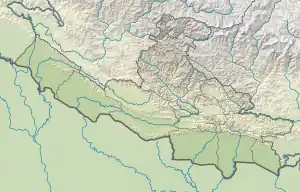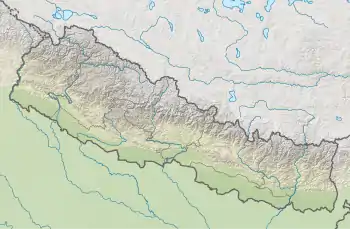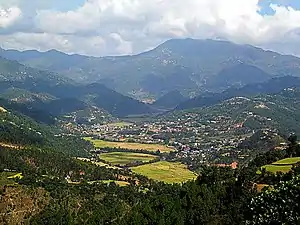Malarani (RM)
मालारानी गाउँपालिका | |
|---|---|
 Malarani (RM) Location  Malarani (RM) Malarani (RM) (Nepal) | |
| Coordinates: 28°04′N 83°07′E / 28.06°N 83.12°E | |
| Country | |
| Province | Lumbini |
| District | Arghakhanchi |
| Wards | 9 |
| Established | 10 March 2017 |
| Government | |
| • Type | Rural Council |
| • Chairperson | Mr. Balkrishna Acharya (RJ) |
| • Vice-chairperson | Mrs. Pramila Kshetri (RJ) |
| • Term of office | (2017 - 2022) |
| Area | |
| • Total | 101.06 km2 (39.02 sq mi) |
| Population (2011) | |
| • Total | 28,044 |
| • Density | 280/km2 (720/sq mi) |
| Time zone | UTC+5:45 (Nepal Standard Time) |
| Headquarter | Khandaha |
| Website | malaranimun |
Malarani is a Rural municipality located within the Arghakhanchi District of the Lumbini Province of Nepal. The rural municipality spans 101.06 square kilometres (39.02 sq mi) of area, with a total population of 28,044 according to a 2011 Nepal census.[1][2]
On March 10, 2017, the Government of Nepal restructured the local level bodies into 753 new local level structures.[3][4] The previous Khan, Khandaha, Bangi, Hansapur, Gorkhunga, Arghatos (half portion), and Mareng VDCs were merged to form Malarani Rural Municipality. Malarani is divided into 9 wards, with Khandaha declared the administrative center of the rural municipality.
Demographics
At the time of the 2011 Nepal census, Malarani Rural Municipality had a population of 28,044. Of these, 99.9% spoke Nepali as their first language.[5]
In terms of ethnicity/caste, 35.6% were Hill Brahmin, 25.6% Chhetri, 15.6% Kami, 13.1% Magar, 5.7% Sarki, 2.8% Damai/Dholi, 0.7% Newar, 0.3% Gharti/Bhujel, 0.2% Sanyasi/Dasnami, 0.1% Gurung, 0.1% Thakuri and 0.2% others.[6]
In terms of religion, 99.8% were Hindu, 0.1% Buddhist and 0.1% Christian.[7]
In terms of literacy, 71.6% could read and write, 1.5% could only read and 26.9% could neither read nor write.[8]
References
- ↑ "District Corrected Last for RAJAPATRA" (PDF). www.mofald.gov.np. Retrieved 17 July 2018.
- ↑ "स्थानीय तहहरुको विवरण" [Details of the local level bodies]. www.mofald.gov.np/en (in Nepali). Ministry of Federal Affairs and Local Development. Retrieved 17 July 2018.
- ↑ "New local level structure comes into effect from today". www.thehimalayantimes.com. The Himalayan Times. 10 March 2017. Retrieved 17 July 2018.
- ↑ "New local level units come into existence". www.kathmandupost.ekantipur.com. 11 March 2017. Retrieved 18 July 2018.
- ↑ NepalMap Language
- ↑ NepalMap Caste
- ↑ NepalMap Religion
- ↑ NepalMap Literacy
External links

